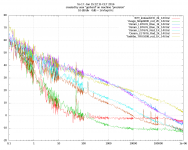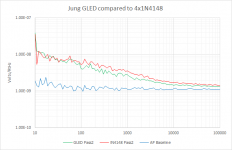LM334 + zero tempco tweak (see datasheet) is an inexpensive and excellent current source, made with on-the-shelf and readily attainable components. Max current is 10mA. LT sells some great ones too, but SMD only.
0Both the LM334 and REF200 are quoted as ~20pA/sqrtHz at 0.1mA.
But the noise goes to > 200pA/sqrtHz at 5mA for the LM334.
I wonder if measurements have been made (public) as to how a simple JFET CCS would compare.
Patrick
But the noise goes to > 200pA/sqrtHz at 5mA for the LM334.
I wonder if measurements have been made (public) as to how a simple JFET CCS would compare.
Patrick
Notes on temperature could have gotten lost on my website, dependent upon how one accessed the GLED431 write up. Sorry about this.
See added comment at the bottom.
Jack, your noise plots are interesting. Do you have an addl reference plot with a 10 ohm R, or a shorted input condition of the preamp?
Thnx.
See added comment at the bottom.
Jack, your noise plots are interesting. Do you have an addl reference plot with a 10 ohm R, or a shorted input condition of the preamp?
Thnx.
I have made some measurements on LEDs, both noise and temperature behavior.
Bought also Walt's LED type, but not tested yet.
I must first complete my preamp designs, wrt 1/f and some phase noise stuff.
Bias source was a NiMH battery 14V, bias resistor is in the filename of the traces.
The red trace is 47 Ohms instead of a LED. Results in slightly less than 1 nV/rt Hz,
so that seems OK. The battery adds no noise.
Bought also Walt's LED type, but not tested yet.
I must first complete my preamp designs, wrt 1/f and some phase noise stuff.
Bias source was a NiMH battery 14V, bias resistor is in the filename of the traces.
The red trace is 47 Ohms instead of a LED. Results in slightly less than 1 nV/rt Hz,
so that seems OK. The battery adds no noise.
Attachments
Last edited:
Notes on temperature could have gotten lost on my website, dependent upon how one accessed the GLED431 write up. Sorry about this.
See added comment at the bottom.
Jack, your noise plots are interesting. Do you have an addl reference plot with a 10 ohm R, or a shorted input condition of the preamp?
Thnx.
Attached is the chart before the two reference values were "RMS's" with the AP Baseline. The amplifier averages ~1.2nV/RtHz (I am embarrassed to quote such a high figure with Gerhard present 🙂 )
Attachments
Attached is the chart before the two reference values were "RMS's" with the AP Baseline. The amplifier averages ~1.2nV/RtHz (I am embarrassed to quote such a high figure with Gerhard present 🙂 )
Thnx Jack. Yes, it is very difficult getting significantly lower, and the RSS extractions always left me somewhat queasy. I suspect only a setup like Gerhard's can really hone in on the actual GLED431 noise. My best guess that it is somewhere twixt 1-2nV/Rt-Hz.
An aside here. Has anyone else noticed that ultra-low Z active ckts seem to show lower noise than a bare diode, LED or other types? My gut instinct is that the low Z helps keep spurious noise down.
Walt Jung
I think that low Z is a precondition, but probably not the cause itself.
I you look at the brown & light blue traces in the plot above, the trace
with the 1K resistor has more noise than the one with 2K bias. The 1K
has nearly twice the diode current and the diode resistance should
therefore be lower. Maybe there is an optimum at even lower current for
these small LEDs?
For high voltage Zeners in true avalanche mode the slope resistance
is even smaller, but the noise is awful.
I remember that for Schottkies the slope resistance has only half-thermal
noise, like it was at 150 Kelvin or so. I don't remember if that's true
for ordinary diodes or even LEDs in forward direction.
I you look at the brown & light blue traces in the plot above, the trace
with the 1K resistor has more noise than the one with 2K bias. The 1K
has nearly twice the diode current and the diode resistance should
therefore be lower. Maybe there is an optimum at even lower current for
these small LEDs?
For high voltage Zeners in true avalanche mode the slope resistance
is even smaller, but the noise is awful.
I remember that for Schottkies the slope resistance has only half-thermal
noise, like it was at 150 Kelvin or so. I don't remember if that's true
for ordinary diodes or even LEDs in forward direction.
Thnx Jack. Yes, it is very difficult getting significantly lower, and the RSS extractions always left me somewhat queasy.
One sanity check is to compare noise of 1k and 10k resistors @1kHz, 10kHz. Also gives you an idea of Zin.
FWIW, here is a PDF version of the GLED431 circuit with relevant comments added. The last section is really important if one is to get the best temp stability. To do this it is necessary to encapsulate the parts in a tube with an RTV surround. Cheap, very simple, albeit messy before setup, alas. 😉
Walt Jung
Walt Jung
Jung pdf file lost in oblivion
Hello,
Would some good-hearted soul mind and upload Walt's pdf file (or put a valid link to it) so that it can be read by present and future generations of hobbyists?
Thanks...🙂
Hello,
Would some good-hearted soul mind and upload Walt's pdf file (or put a valid link to it) so that it can be read by present and future generations of hobbyists?
Thanks...🙂
The Solution = WayBack Machine (archive.org)
Walt's entire blog is viewable here:
About This Blog… | Walt's Blog 2014
Awesome!
Walt's entire blog is viewable here:
About This Blog… | Walt's Blog 2014
Awesome!
FWIW, here is a PDF version of the GLED431 circuit with relevant comments added. The last section is really important if one is to get the best temp stability. To do this it is necessary to encapsulate the parts in a tube with an RTV surround. Cheap, very simple, albeit messy before setup, alas. 😉
Walt Jung
That link no longer is operative. I tried to upload the correct PDF version here, but this system won't allow a 1.5meg filesize (???). What a frustration...
One user did email me, and I am sending him a PDF direct.
Walt Jung
PS: The GLED431 threshold is mentioned as being 5mA, but actually higher currents can help lower the noise. Try for 7-8mA. The reason for this is that with the GLED running at 4mA, the ZTX951 PNP only gets 1mA with 5mA supplied, not the best. So running the same current (4/4) in the LED and the PNP should help out, noise-wise that is.
Last edited:
The GLED431 threshold is mentioned as being 5mA, but actually higher currents can help lower the noise. Try for 7-8mA.
Posts #5 and #8 in this thread also recommend >= 7mA thru the GLED431, for another reason (not noise) which you can read about. So that's two justifications for running at 7mA instead of 5.
Here is a LINK to the GLED note from December 2015, found on waltsblog using the Internet Wayback Machine.
I also sent it to .pdf , which I have attached below.
_
No, that "Wayback" link is NOT correct, as it lacks additional notes I had made on scaling and thermal isolation. There are so many holes in those so-called "Archives" it makes me very, very sad to see people referencing it.
I'll send anyone who requests it the real GLED431 PDF.
Walt Jung
Last edited:
No, that "Wayback" link is NOT correct, as it lacks additional notes I had made on scaling and thermal isolation. There are so many holes in those so-called "Archives" it makes me very, very sad to see people referencing it.
I'll send anyone who requests it the real GLED431 PDF.
Walt Jung
Mark Johnson kindly shrank the GLED431 PDF in question down to a much more reasonable size.
Thank you Mark, I'm tickled that this makes the info more accessible.
Walt Jung
Attachments
Hi all
Did any of you built a 3.3V temperature stable reference?
We need one for a ES9038 AVCC upgrade��
Thank you for all inputs.
Did any of you built a 3.3V temperature stable reference?
We need one for a ES9038 AVCC upgrade��
Thank you for all inputs.
How about GLED431 + opamp + two resistors? Do a good job selecting the opamp and the resistors ---> success, is it not so?
Walt might have been expecting that users would drive his GLED431 with a very high impedance (like a constant current source), in which case the Zout of the GLED431 is not so important. So I ran a simulation of that case, shown below. Bias current in the simulated GLED431 is 7mA. The output VREF remains constant despite rather large changes in the applied voltage.
_
Mark have you simulated this circuit regarding temperature diviations from example 10 to 60 degrees?
- Home
- Amplifiers
- Power Supplies
- Mr. Jung's ultra-low noise VREF - the GLED431

